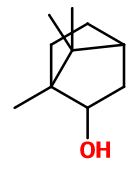
Photo credits: ScenTree SAS
Do you sell any of the raw materials? Would you like to let our users know?
Send an email to fournisseurs@scentree.coto learn about our advertising opportunities.
Do you sell any of the raw materials? Would you like to let our users know?
Send an email to fournisseurs@scentree.coto learn about our advertising opportunities.
General Presentation
-
CAS N° : 464-45-9 / 507-70-0
-
EINECS number : 207-353-1
-
FEMA number : 2157
-
Density : 0,986
-
Optical rotation : Donnée indisponible
-
Allergens : This ingredient does not contain any allergen.
-
Refractive Index @20°C : Donnée indisponible
-
Volatility : Head
-
Price Range : €€
-
Appearance : White solid
-
FLAVIS number : 02.016
-
JECFA number : 1385
Information on synthetic ingredients
-
Acid Value : Donnée indisponible
-
Boiling Point : 210°C
-
Detection Threshold : 140 ppb
-
Molecular formula : C10H18O
-
Log P : Donnée indisponible.
-
Molecular Weight : 154,25 g/mol
-
Fusion Point : 207°C
-
Flash Point : 66°C
-
Vapor pressure : Donnée indisponible
Uses
Other comments :
Borneol is more used than Camphor in perfumery, with a relatively similar olfactory effect. Borneol is a 'trigeminal' raw material. This means, it involves the trigeminal nerve, responsible for a motor and sensitive function for humans. In the case of Borneol, smelling it gives the nose a sensation of cold.
Stability :
Terpenes tend to polymerize by oxydation. For Borneol, its stability is satisfying because it doesn't have any double bond.
Uses in perfumery :
Borneol is used in lavender reproductions, in terpenic and coniferous notes to bring a top note and a cold effect starting from the top.
Year of discovery :
Data not available.
Isomerism :
The molecule called Borneol is actually the laevorotatory isomer of this molecule. The dextrorotatory isomer is called Isoborneol. The smell of Isoborneol is more balsamic than Borneol. These molecules are used in perfumes for the same reasons. In addition, Borneol is a constitutional isomer of another terpene called Terpineol which smell is much more rosy and etheric, reminiscent of solvents.
Synthesis precursor :
An oxidation of Borneol allows to obtain Camphor. From this Camphor, Camphene is obtained by dehydrating it with an acid treatment. Finally, Borneol can be esterified into several esters, to form Bornyl acetate, for example. Although, bornyl esters are prepared differently on an industrial scale.
Natural availability :
Borneol is present in several natural compounds, including Lavender EO, Pinaceae essential oils and Lemongrass EO among others. The synthesis of this compound is preferred to its extraction, as it is not present in sufficient quantities in the essential oils.
Synthesis route :
The synthesis of Borneol is made from beta-Pinene, by a Wagner-Meerwein rearrangement, putting pinene in contact with acetic acid. The latter forms an acetate which is derived. Then, an alkaline hydrolysis takes place with this compound using potash, to replace this acid group with an alcohol group, in order to form the final Borneol (in parallel, the potassium acetate that has formed is removed).
Regulations & IFRA
This ingredient is not restricted

